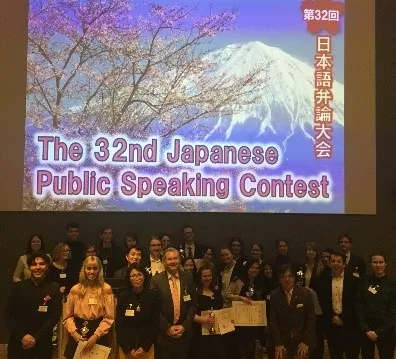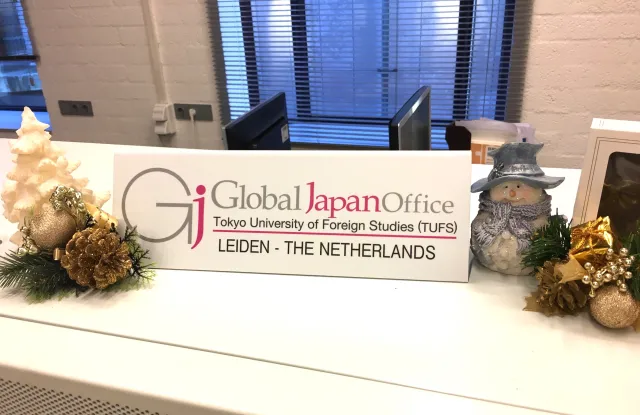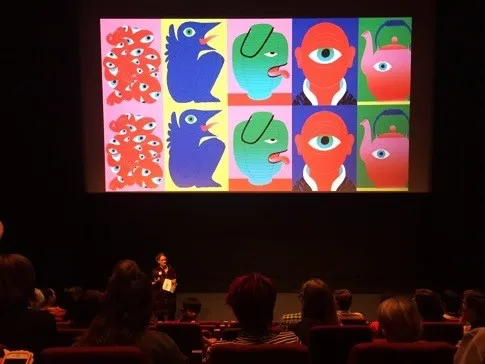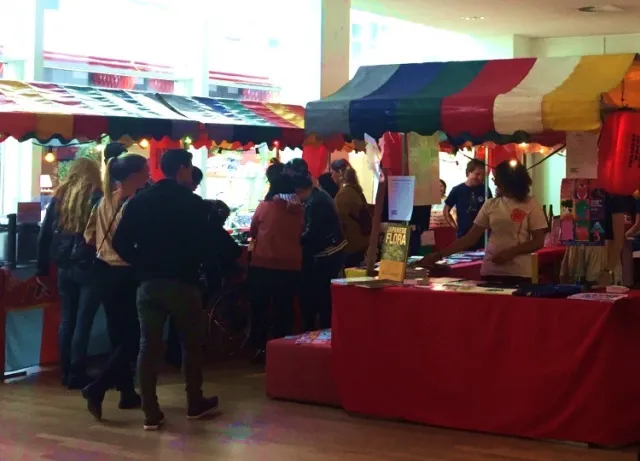2018 Activity Report
March Activity Report
31 March 2019
Global Japan Office Coordinator
Yuri Oyama
The sunlight hours are longer in March, and the spring tulips are starting to bloom all around the city. You can hear birds cheerfully chirping outside the windows of the classrooms, and one of my students exclaimed “ah! Spring is here!” in the middle of class. This wonderful expression warmed my heart.
On the 23rd, a Japanese Speech Competition was held by the Embassy of Japan in the Netherlands in The Hague, and eight students participated from Leiden University. In preparation for this, the GJO formed a Speech Club and, with the assistance of five Japanese exchange students, helped the students practice for the competition.
Students could choose any topic to talk about, so they all thought of topics they were interested in. Their topics were very interesting and ranged from “Japanese Food Culture”, “The Films of Miyazaki Hayao”, and “The Takarazuka Revue” to “Japan’s Garbage Problems” and “Japan’s Gender Gap”.
Everyone received results worthy of their efforts, and four students from Leiden won awards including the “Special Award”, the “Award of Excellence” and the “Kochi Yosakoi Award”. Everyone seemed satisfied after the competition, and some students even said they want to participate again next year.
Students studying Japanese at The Hague Campus also came to cheer on their upperclassmen. Many of these students watched the speeches and commented on how they wanted to become as good at Japanese as their “Japanese senpai”, so I think it was a good incentive for them.
It takes courage to stand in front of an audience and give a speech in another language such as Japanese. Regardless of whether they won awards or not, the students did great.

February Activity Report
28 February 2019
Global Japan Office Coordinator
Yuri Oyama
February in Leiden was warmer than usual, with some days reaching 18 degrees. Dutch winters are usually cold and gloomy, but this month there were many pleasantly warm days with dazzling sunlight, and I saw many people walking around outside in t-shirts.
This month, the new semester finally began at Leiden University. I am always incredibly nervous for the first class of the semester. As always, I headed to my classes wondering what kind of students I would have this time.
The first-year students this year are very enthusiastic, and cheerfully progressed from the very first class. Many students memorized hiragana and katakana before the semester began, and many students also studied Japanese on their own through watching anime and dramas, so there were many questions about Japanese not found in the textbook. I heard some students speaking in Japanese amongst themselves during their break time, and some students even came to talk to me in Japanese, so I could really feel their enthusiasm.
I also resumed Conversation Club activities this month. Both first-year and second-year students participated this month, so I had them introduce themselves and ask each other why they chose to study Japanese. Answers included statements such as “I liked anime as a kid, so I’m interested in Japan” and “I like ramen and sushi, and I want to go to eat them in Japan, so I am studying Japanese”. One student even said they want to start a company in the future and do business with Japan.
The students are so motivated, which in turn makes me motivated. I hope to keep this motivation alive this semester.
January Activity Report
31 January 2019
Global Japan Office Coordinator
Yuri Oyama
Happy New Year everyone. In Leiden, fireworks are set off as soon as it becomes the new year, so 2019 began rather festively. In The Netherlands, fireworks are often associated with the New Year. Leading up to New Year’s Eve, many people and their families buy fireworks, and set them off simultaneously around the city when the New Year arrives.
You may think that the fireworks people set off at home are smaller ones, but actually they are usually big ones, much like those set off at summer firework festivals in Japan. People continued to do fireworks for two hours after the New Year began, so it was an interesting sight that you definitely wouldn’t see in Tokyo.
This month I was busy preparing for the spring semester that starts next month with the teachers of my course. The absolute beginner’s course will begin this spring. The absolute beginner’s course is for students who haven’t studied Japanese before, and they will start by studying hiragana and katana. I have been brainstorming ideas with the other teachers to figure out what materials we need to prepare, what order we should teach things in, and how we can make the students’ introduction to Japanese a smooth one.
Even with hiragana, there are many differing opinions on the order it should be taught in, including the traditional syllabary order, and starting from easier characters such as し (shi) and つ (tsu). We will work hard this semester to figure out the best way to teach this course, with a touch of trial and error.
Please look forward to my reports for the upcoming year.
December Activity Report
31 December 2018
Global Japan Office Coordinator
Yuri Oyama
In December, the Christmas Markets began in Leiden. Choirs and bands have been performing on special stages, and the streets have been lively enough to blow away the gloomy and cold winter weather. I also redecorated the GJO sign to get in the Christmas spirit. The skies outside are still cloudy and grey, but I think the decoration made the inside of the office brighter.


Final exams were held this month, and the students seemed stressed in the last stretch of the semester. Many students came to ask me questions during the intervals between their classes, so I felt they were just as enthusiastic as ever about Japanese.
At this month’s Conversation Club at The Hague Campus, we talked about our plans for the winter break and what we would do for Christmas. Christmas in Europe is usually spent with family, so most of the students will go home for the holidays. One student even brought their suitcase to the club meeting, saying they were heading home afterwards. Apparently they planned it like this on purpose because they enjoy the club so much, which made me really happy to hear.
Some students who completed the Japanese course last year also visited the club. It seems some of the students heard their upperclassmen speak Japanese and set a new goal to be able to speak like them by the end of their course next year. From what the students have told me, it seems the students in the Japanese course at The Hague Campus don’t have many connections with the students from previous years. Up until now I have been splitting time at the Conversation Club to cater to different levels, but maybe it would be good to make time for the levels to mix as well. Thank to the many people who supported me in 2018, I was able to end the year successfully. Thanking you all in advance for the next year.
November Activity Report
30 November 2018
Global Japan Office Coordinator
Yuri Oyama
Leiden in November is very cold and the days are increasingly gloomy. However, the glistening Christmas trees and Santa Claus decorations being put up around the city beg to differ.
This month, many of my students had good news to announce, namely along the lines of “I got accepted for study abroad in Japan!”. While their exchanges are set to start next year (from summer to fall), they are already looking forward to being in Japan, and have been talking about all the museums they want to go to and food they want to eat. I feel even more motivated to teach them Japanese so they can fully enjoy their time in Japan.
At this month’s Conversation Club, we talked about “katakana words”. One student said they found katakana words difficult and had trouble understanding them. One of the Japanese exchange students said they thought katakana words would be easy to understand, as they mostly come from English, but the students said the pronunciation is too different for them to recognize them as English words.
Even at the Conversation Club, native Japanese speakers, myself included, have a tendency to think that katakana words are easier to understand. For example, we might say “last night I ate toriniku…chikin”, with chikin being the katakana word for chicken. While most Japanese people think of katakana words as being English words, the Dutch students can only hear them as being Japanese.
Currently in Japan, many Japanese words are being replaced by katakana words. If you go to a department store, the signs read “reidiisu furoa” (ladies floor), “menzu furoa” (men’s floor), “kizzu furoa” (kid’s floor); restaurant menu’s read “biifu” (beef), “raisu” (rice) and “ranchi” (lunch). In this case, even if students know the Japanese word for beef, “gyuuniku”, they might not be able to understand if a menu simply says “biifu”.
Even commonly-used katakana words often don’t make it into Japanese textbooks, so there is a gap between the Japanese used inside and outside of the classroom. I am trying to teach my students as much as I can so that katakana words don’t join the list of common complaints alongside crowded trains and cellphone contracts.
October Activity Report
31 October 2018
Global Japan Office Coordinator
Yuri Oyama
It is now October here in Leiden, and temperatures have dropped since last month. The mornings are particularly cold, and it has been 4-5 degrees every day during my commute to the campus. People in the city are wearing more winter-worthy clothing, and most people I see are wearing down jackets and boots. On the other hand, I do sometimes see people wearing t-shirts and tank tops, which is a strange site to see and makes me feel like it’s both summer and winter at the same time.
This semester’s Japanese Conversation Club began meeting this month. The Japanese exchange students are also participating in club activities, so there’s always around 6-8 people, and everyone excitedly speaks Japanese. The Leiden students who participated were all elementary level, and have only finished half of the elementary textbook, so they started with self-introductions, then talked about their countries, cities and interests.
Also, on October 19, as part of Japanese Snacks Day, I gave Japanese snacks such as mochi and rice crackers to the students who attended the Conversation Club. There are many vegetarian and vegan students here, but many Japanese snacks don’t use animal products, so they were able to eat them without a problem. The students particularly liked the mocha filled with red bean paste and green tea bean paste, and students who had never had mocha before said “so this is what you were talking about in class” and “so this is what mochi is”. However, the students were divided on the ume (plum) rice crackers. Some students said they didn’t like the taste of plum.
Among the students here, it seems that many of them watch anime and are familiar with the words “ume” and “mochi”, but until now had never actually tried them. I am glad they finally had the chance to try Japanese snacks.
At the end of this month I asked students how they felt about the Conversation Club, and they said that the Japanese used at the Club and the Japanese used in class is very different, so there were many things they didn’t understand.
This doesn’t necessarily mean that the Japanese exchange students were using difficult words, but rather that Japanese is that kind of language. It is said that Japanese had a lower vocabulary coverage than English or French, so it takes time for learners to understand regular conversations. For example, if you take the 1000 most frequently used words of a language, you’ll find that the top 1000 in English cover about 80% of words used in day-to-day conversations, but the top 1000 in Japanese only cover about 60%. To understand 80% of the words used in regular conversations in Japanese, it is said that you must memorize about 5000 words, which is equivalent to the intermediate level of the Japanese Language Proficiency Test.
When teaching Japanese, teachers tend to use words and grammar they know the students will understand, so some students may not feel this level of difficulty. However, when students leave the classroom and talk to Japanese people, all of a sudden they are bewildered by the amount of words they don’t understand. There are probably some students who feel they won’t ever learn enough to keep up. My students have just finished half of the elementary textbook, so now is their time to persevere.
Anywho, the students at the Japanese Conversation Club were trying their best to use vocabulary they know. After the club meeting, I saw the students exchange contact information with the Japanese exchange students. I think they will be more motivated to study Japanese if they have Japanese friends.
I will hold the Conversation Club meeting again next month. I will keep working hard to ensure my students have a fun place in which they can come in contact with and practice Japanese.
September Activity Report
30 September 2018
Global Japan Office Coordinator
Yuri Oyama
September in Leiden is cool thanks to the nice autumn breeze.
The summer break ended in September, and the new academic year began at Leiden University. We welcomed some new exchange students from Japan, which was a fun way to start the new semester.
On September 11 I held a friendly meeting with the Japanese exchange students. 12 students came to this meeting, at which we casually introduced ourselves and asked questions about one another.
I think they will support and encourage each other during the many experiences they will have throughout their exchange lives, which are only just beginning. They may even make some lifelong friends that they otherwise wouldn’t had they not come to Leiden. The students come from all over Japan, so they will probably also experience culture shock amongst themselves.
As the GJO coordinator, I will continue to support these students so they can have a successful study abroad year.
From September 26-30, the “CAMERA JAPAN Festival 2018”, a Japanese film festival, was held in Rotterdam, so I went to check it out. The festival was bustling with people, and aside from the films there were also other attractions such as food stalls and tea workshops, so visitors could enjoy many aspects of Japanese culture.
Before the film screening, a lecture was held to explain facets of Japanese culture and any points necessary to appreciating Japanese film. Throughout the whole event, I could feel how interested people in The Netherlands are about other cultures.
From here on out, The Netherlands is heading into winter. I will do my best next month to fight through the cold.


June Activity Report
30 June 2018
Global Japan Office Coordinator
Yuri Oyama
June in Leiden is warmer, and the days have become longer. While the sun goes down in the evening almost immediately during the winter, summer nights are still light out until about 10pm. On sunny days, you can see many people around the city basking in the sun, as if to make up for the rays they missed in winter. Some people even put dining tables outside their homes to eat in the sun, which made me realize how important the sun is to Dutch people.
The Japanese Conversation Club was held four times this month. Students going on exchange in the fall turned up to practice their spoken Japanese, and some students just came so they wouldn’t forget Japanese over the summer vacation.
This month’s Conversation Club topics were quite advanced, as topics such as euthanasia and capital punishment were discussed. I also taught the students some phrases that will help them convey their opinions, which I thought would be useful for those going on exchange. These were:
“〇〇 has this opinion, but…”
“I think you should…”
At first, the students conveyed their opinions in English, and I helped them say these in Japanese, but after a while everyone started to put their opinions together bit by bit, and were able to say them in Japanese.
Also, while I was worried that these topics were too difficult, many of the students are interested in topics such as human rights and crime, so they came prepared with vocabulary related to these topics, and excitedly exchanged their opinions on them.
All the final exams and supplementary exams for the spring semester ended this month, and the 2017-2018 academic year came to an end. 10 months have passed since I started teaching Japanese in Leiden University’s Japanese Studies program and International Studies program in September 2017. I struggled a little at first, as there were many differences from the Japanese education I experienced in Japan, but the students and teachers around me were warm and supportive, so I had a good year.
The summer vacation will start in July, and the next semester will start in September. I am going to use this summer to reflect on the last semester and prepare for the next one.
May Activity Report
31 May 2018
Global Japan Office Coordinator
Yuri Oyama
This month, Japanese classes ended for the semester, and the final exams began. Students of the International Studies program’s Japanese class have a written exam, and also have to submit a video project as their final assignment. For the video project, I had the students make videos on topics related to the grammar structures they learnt during the semester. We watched all the submitted videos in the last class of the semester, and shared our opinions on them together.
A group of first-year students made a video introducing their favorite shops and streets in The Hague. The students were able to combine the grammar structures they learnt during the semester to describe the things around them:
“I often drink coffee at this café. The coffee here is delicious.”
“I come here often with my friends. We talk a lot.”
“I went to the beach last week. It was cold.”
From the above, it can be seen that first-year students focus more on grammar structures that can be used to describe tangible things, but second-year students learn how to talk about more abstract things. One group of second-year students filmed themselves discussing the topic of “what do you think of Dutch people?”
Another group made an interesting video, set in a restaurant, in which Dutch and Japanese people pointed out each other’s strange gestures and habits. For example, in the video, a Japanese student calls out “excuse me, I’d like to order” and beckons the waiter to come with their palm facing downwards – to which a Dutch student says “what? That gesture means ‘go away’. In Holland we use this gesture,” after which they beckon the waiter with their hand facing upwards. This video was popular among their classmates, who all watched with great interest.
In the year and a half since they began studying Japanese, the second-year students have not only learnt about the Japanese language, but also about Japanese culture and customs. The International Studies program’s Japanese class will end this spring for the second-year students, so I’m glad they could demonstrate the fruits of their efforts by putting their all into these video projects.
I hope the first-year students are able to do and say as much in Japanese next year as the second years were able to this year. I too intend to prepare myself over the summer so I can continue to teach effectively.
April Activity Report
30 April 2018
Global Japan Office Coordinator
Yuri Oyama
The final exams are finally drawing closer, and before I knew it, it was April. It was warm at the start of this month, and you could see many tulips growing in the streets, but the latter half of April was cold, with the temperature only reaching around 12 degrees at midday.
This month I opened a Japanese Conversation Club for beginner-level students. Since there is a speaking test in the final exam, I thought it would be a good idea to give students an opportunity to practice.
I was actually quite worried about the club initially. The students haven’t learnt many grammar structures yet, so I was worried about what I should do if they get nervous and don’t speak at all. I thought that maybe it would just turn into me asking them questions one by one, and I had no idea how it would turn out, but I nervously headed to the meeting place in the cafeteria anyway.
I arrived a little early, but the students were already there waiting for me. We all gathered around one table, and the students introduced themselves one by one. After this, I had them talk amongst themselves freely.
“What do you usually do in the weekends?”
“I often go shopping. Sometimes I watch Japanese movies with my friend.”
“Really? What kind of movies do you like?”
The students used the grammar structures they have learnt to actively ask each other questions and expand their conversations. Occasionally they would ask me how to say something in Japanese, but mostly I felt that the students were having so much fun that I didn’t even need to be there.
I am really surprised that these students, who started from hiragana and katakana in February, can already communicate this much in Japanese. I could tell that they were working hard just from looking at their tests and homework, but now I can really feel how interested the students are in Japanese. There are only a few weeks left until the final exam, but I want to work hard to teach to a standard that meets my students’ needs.
